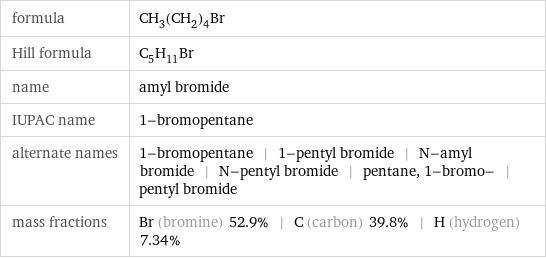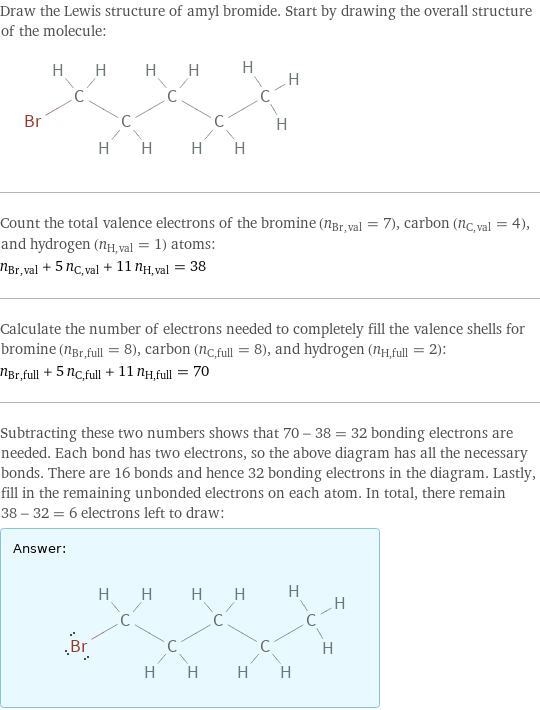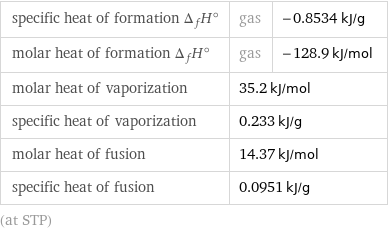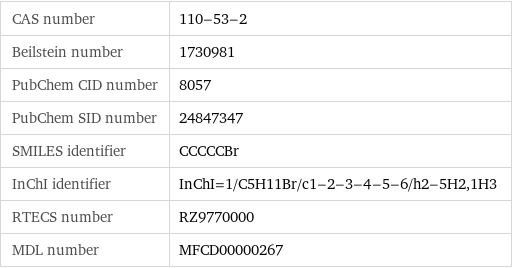Input interpretation

amyl bromide
Chemical names and formulas

formula | CH_3(CH_2)_4Br Hill formula | C_5H_11Br name | amyl bromide IUPAC name | 1-bromopentane alternate names | 1-bromopentane | 1-pentyl bromide | N-amyl bromide | N-pentyl bromide | pentane, 1-bromo- | pentyl bromide mass fractions | Br (bromine) 52.9% | C (carbon) 39.8% | H (hydrogen) 7.34%
Lewis structure

Draw the Lewis structure of amyl bromide. Start by drawing the overall structure of the molecule: Count the total valence electrons of the bromine (n_Br, val = 7), carbon (n_C, val = 4), and hydrogen (n_H, val = 1) atoms: n_Br, val + 5 n_C, val + 11 n_H, val = 38 Calculate the number of electrons needed to completely fill the valence shells for bromine (n_Br, full = 8), carbon (n_C, full = 8), and hydrogen (n_H, full = 2): n_Br, full + 5 n_C, full + 11 n_H, full = 70 Subtracting these two numbers shows that 70 - 38 = 32 bonding electrons are needed. Each bond has two electrons, so the above diagram has all the necessary bonds. There are 16 bonds and hence 32 bonding electrons in the diagram. Lastly, fill in the remaining unbonded electrons on each atom. In total, there remain 38 - 32 = 6 electrons left to draw: Answer: | |
3D structure

3D structure
Basic properties

molar mass | 151.05 g/mol phase | liquid (at STP) melting point | -95 °C boiling point | 130 °C density | 1.218 g/cm^3 solubility in water | insoluble
Units

Liquid properties (at STP)

density | 1.218 g/cm^3 vapor pressure | 13 mmHg (at 25 °C) dynamic viscosity | 8.6×10^-4 Pa s (at 15 °C) refractive index | 1.444
Units

Thermodynamic properties

specific heat of formation Δ_fH° | gas | -0.8534 kJ/g molar heat of formation Δ_fH° | gas | -128.9 kJ/mol molar heat of vaporization | 35.2 kJ/mol | specific heat of vaporization | 0.233 kJ/g | molar heat of fusion | 14.37 kJ/mol | specific heat of fusion | 0.0951 kJ/g | (at STP)
Chemical identifiers

CAS number | 110-53-2 Beilstein number | 1730981 PubChem CID number | 8057 PubChem SID number | 24847347 SMILES identifier | CCCCCBr InChI identifier | InChI=1/C5H11Br/c1-2-3-4-5-6/h2-5H2, 1H3 RTECS number | RZ9770000 MDL number | MFCD00000267
NFPA label

NFPA label

NFPA health rating | 1 NFPA fire rating | 3 NFPA reactivity rating | 0
Safety properties

flash point | 31.11 °C autoignition point | 206 °C

DOT hazard class | 3 DOT numbers | 1993
Toxicity properties

RTECS classes | other